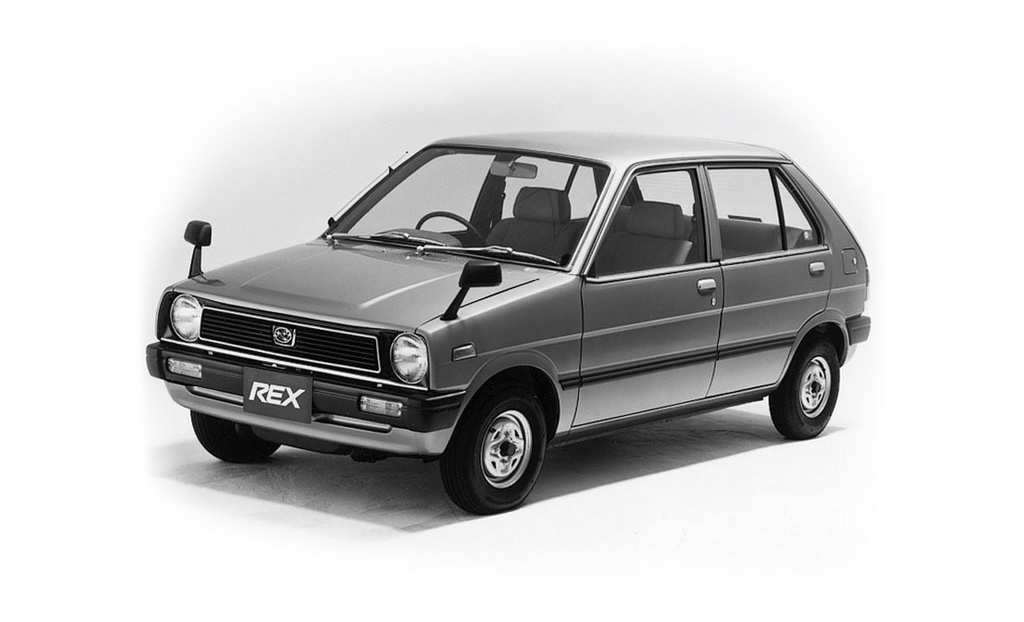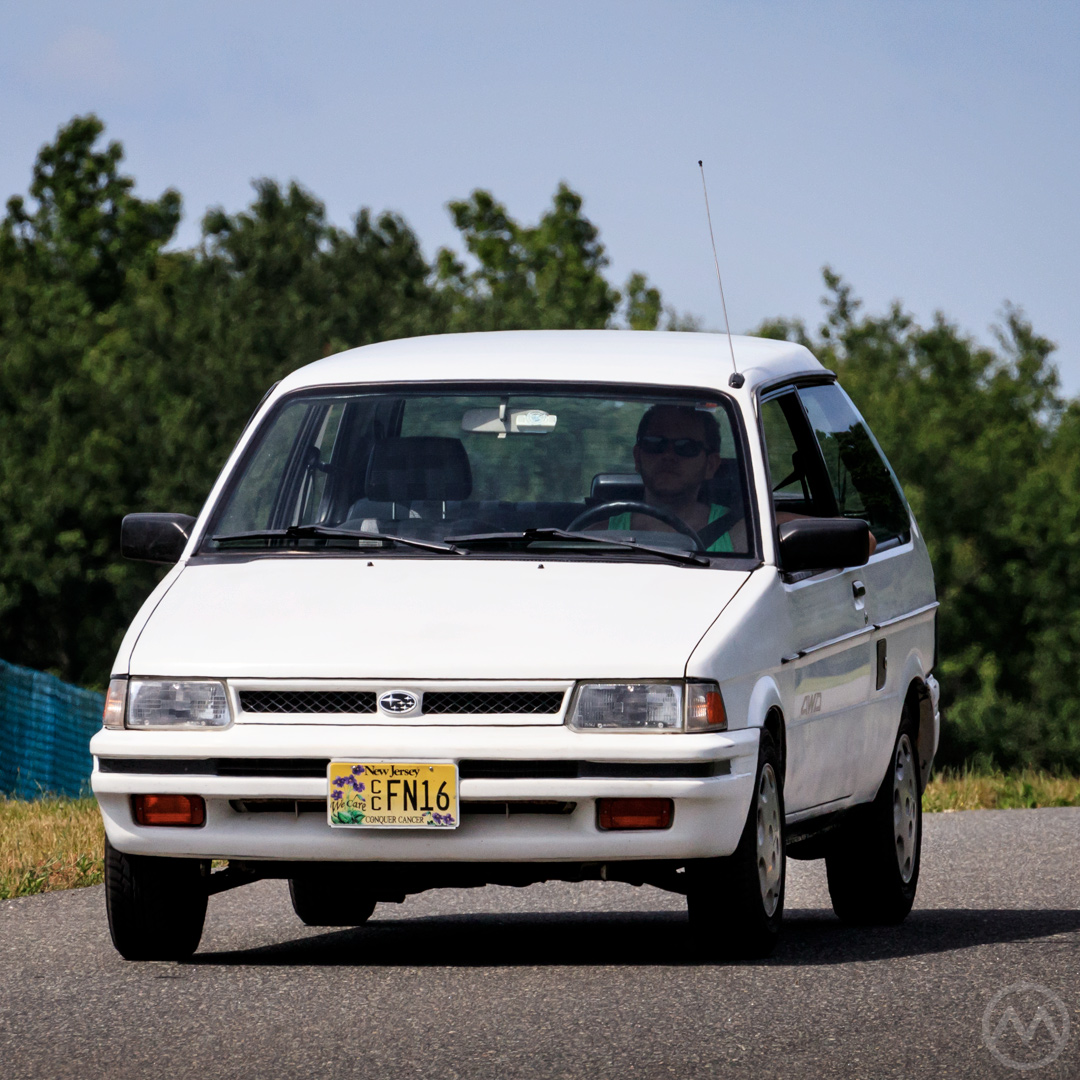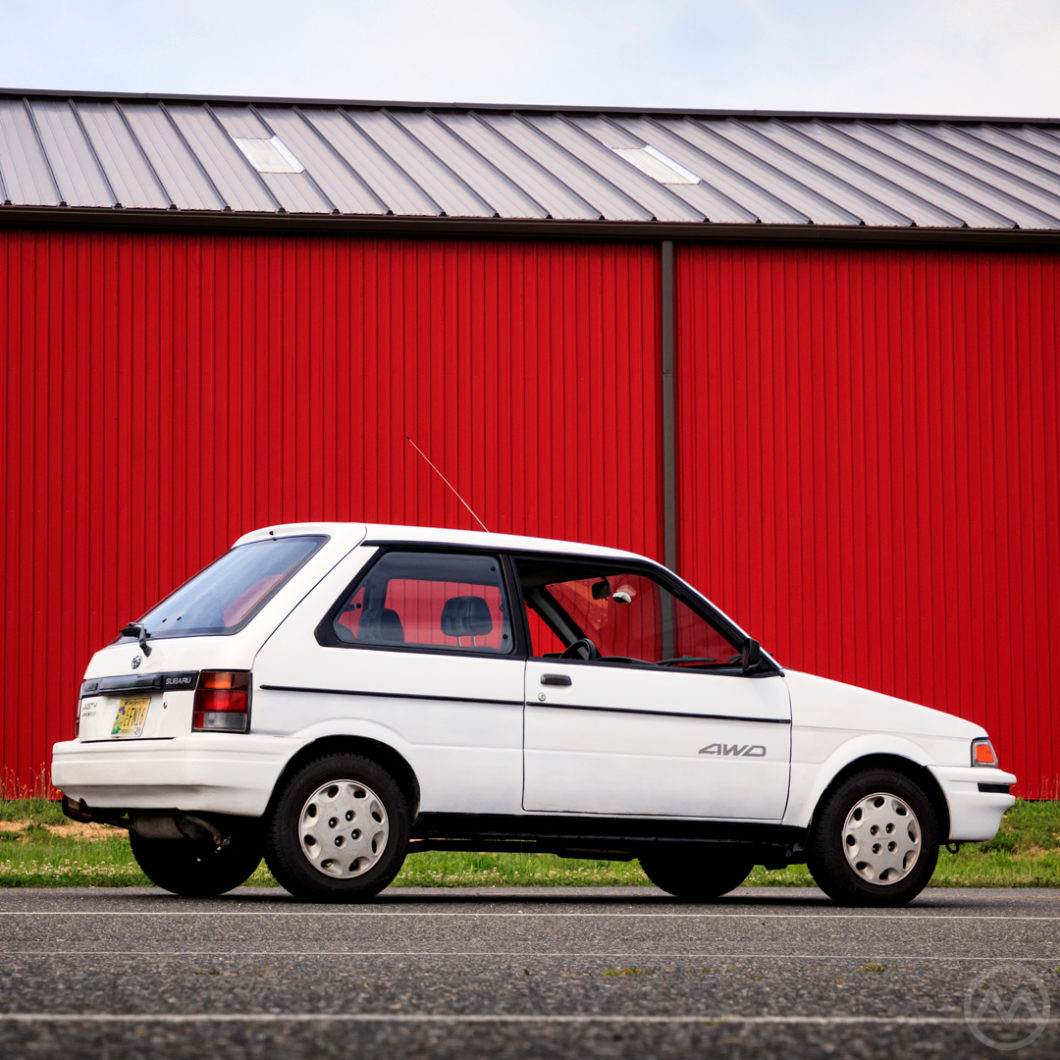It was basic transportation in the eyes of American consumers. As small a car as you could get, with as small an engine as many of them could remember. The Subaru Justy, which arrived on American shores in 1987, was just 139” (353cm) long, wore narrow 12” (30cm) wheels, and was powered by an 1,189-cc triple.
Only the Chevy Sprint had a smaller engine. Even Yugos had four cylinders. To the young buyers Subaru was aiming the car at, the Justy was decidedly uncool.
The triple may have held the the little Subaru back with skeptics, but the automaker had some innovations up its sleeve that made the Justy something more special. In 1988 the automaker made four-wheel drive (4WD) available. A year later it got an optional continuously variable transmission (CVT). While the CVT ended up as just a novelty, the four-wheel drive set the Justy apart from the crowd and it proved a surprisingly robust car for something generally thought to be cheap and disposable.
The story begins in 1981, with an even smaller Subaru, the Rex, a distant descendant of the only comparable previous Subaru in America, the 1960s-era 360. The Justy, you see, is the offspring of a Kei car.
Kei Car Beginnings
Subaru’s tiny 360 was its first volume-production vehicle. Though it had experimented with larger cars, like Mazda and Suzuki the company started small with a Kei-class vehicle geared to the budgets of 1950s Japanese car buyers.
The 360 was imported to the U.S.A. by Malcolm Bricklin, who would later be responsible for the importation of the Yugo, but the tiny car proved a hard sell and Subaru of America’s sales didn’t amount to much until the Leone arrived. The aging 360 gave way to the R-2 in 1969, which was in turn replaced by a mostly new design, the Rex, in 1972.
The Rex (latin for “King”) looked more like a regular car than the 360, but it was still a rear-engine vehicle and still powered by a 360-cc two-stroke twin as demanded by Kei regulations. It was larger and heavierto accommodate buyers who wanted something less basic than the early Subarus, but that also made it very slow. Kei sales plunged in the 1970s as emissions regs further reduced their performance and Japanese buyers increasingly chose bigger cars.
The Rex was gradually upgraded to meet emissions rules and given enlarged engines as the Kei formula was widened, but it was never an unqualified hit, and Subaru began working on a replacement in 1977.
For its second generation, the Rex would be a front-engine, front-drive vehicle, an arrangement which made for much better packaging and which almost every Japanese manufacturer was adopting for their 1980s Keis. Daihatsu, a key rival, got there first, with the front-drive Mira Cuore in the summer of 1980, and the MkII Rex arrived about a year later, in August of 1981.
Only the engine remained from the old car, now transversely mounted. The front-drive setup made it much easier to equip the Rex with what was becoming Subaru’s defining feature, four-wheel-drive, which was added to JDM versions in 1982 along with an optional turbocharged twin. In just two years, the Rex had become one of the most advanced Kei cars around, but you’d never have known by looking thanks to its relatively bland design.

Daihatsu, in the meantime, fitted a larger 612-cc engine to the Mira and began selling it in Europe as the Daihatsu Domino. Envious of that success, Subaru followed suit in September of 1982. The company fitted the Rex with a 665-cc version of its two-cylinder, bigger bumpers and bigger wheels and began selling it in Europe as the Subaru 700.
The 700 wasn’t a bad seller, but Europeans considered it very basic transportation and there were plenty of alternatives on the continent, including even cheaper cars like the Fiat 126. Fuji was keen export even more cars, but between the 700 and Subaru’s Leone-based cars yawned a huge chasm.
To fill the gap, in 1982 Subaru began engineering an enlarged Rex, stretched and widened but re-using some key stampings to keep costs down. This “new” car arrived as the Justy in 1984. It looked exactly like what it was – a bigger, longer, wider Rex. At home and in Europe, the cars were again aimed at Daihatsu and Suzuki, but this time they took aim at the 1-liter class Charade and Cultus.
Meanwhile, a wave of very small cars largely planned in the early 1980s when gas prices were high, began to appear in the U.S. New bargain-binners like the Yugo and the Hyundai Excel were soon selling in fair numbers based on their ultra low prices, but they soon got a captive import competitor, Chevrolet’s Sprint. That car, of course, was a badge-engineered Suzuki Cultus. Watching that car go on sale, Fuji Heavy Industries was sure it could sell the Justy here too.
Justy comes to America
The original Japanese-market Justy was 6” (15cm) wider, 14” (36cm) longer overall, and rode a 2” (5cm) longer wheelbase than the Rex. In place of the little twin there was now a 997-cc triple, the EF10.
Essentially the Rex engine with one more cylinder, the EF10 had a chain-driven balance shaft to try and smooth out vibration inherent in triples. “Try” and “succeed” are two different things, and Subaru never did entirely tame the rough-and-tumble feel of the engine. The car came only with a five-speeder at first. In their original Japanese form, they were quite light too. The top-spec RS 4WD weighed only 1,500 lbs.
Small 4WD cars are uncommon because their running gear adds weight and complexity – which typically undercuts the purpose of small economy cars, but in the Justy it was a good add. The 4WD setup made the car unique – only Fiat really offered something similar in the Panda 4×4, but the two rarely overlapped. Subarus weren’t common in Europe and Fiats were rare in Japan. Plus, Turin had abandoned North America in 1983.
For American highways an 1,189-cc version of the EF triple, the EF12, was created to give the car a little more power. The Justy got a little structural reinforcement to hold up in U.S. crash tests. Subaru of America was a little skeptical about the tiny car, but Fuji was keen to sell it here. The little cars began arriving in August and September of 1987 with a base price of $6,525, a little bit more than the Sprint and $2,000 more than the Yugo.
Growing the Justy
At first Justies came only with front-wheel drive and a manual transmission. It was cheap and came with a warranty, but the front-drive Justy was considered only slightly “better than walking” by most consumers when it first arrived, not helped by its price disadvantage and, despite being much bigger than the Rex, it’s tiny size. But the arrival of the 4WD option in the summer of 1988 changed that.
It added a hefty $1,500 to the price on the base model DL and $1,100 on the nicer RS, but it greatly enhanced the overall package and made the Justy a vehicle with essentially no direct competitors. It would never be flashy, but it was unique and tied the car more closely to the other Subarus, already well respected for capability and value.
Subaru buyers liked that it was the “4WD company” and Justy sales more than doubled from a rather anemic ~13,000 the first year to ~27,000 in 1988, the car’s best year in America. In Europe, the slightly cheaper, slightly smaller Panda 4X4 was a much bigger seller, but Fiat was more of a known quantity to Europeans and Turin’s dealer network there was far stronger than Subaru’s.
Regardless of the excellent results in 1988, the Justy was three-and-a-half years old when it was launched in the USA and it was due for a refresh. That fall, Subaru comprehensively updated the car with much more of an eye towards export markets than JDM consumption.

Continuously Shifting
The car was stretched a further 6” (15cm) overall to give it more luggage space – though anybody who’s been in one can tell you it was still a very small car in back. The roof was raised to give taller drivers more headroom. The styling was refreshed to make it look (though not actually be) more aerodynamic and contemporary than the circa-1981 styling borrowed from the Rex.
Underneath there was yet another really new and different feature. The 1989 Justy became only the second vehicle ever offered in America with a Continuously Variable Transmission (CVT). At the time, it was referred to primarily as a “constantly variable transmission.”
Americans, of course, want automatics. Even in 1988, when many small cars still offered manual transmissions, Automatics were king. Small cars that did not offer an automatic option were inherently not going to sell as well as those that did, a fate experienced by Fiat and Yugo, though those brands had other issues.
Subaru felt that putting a conventional automatic in the Justy would siphon far too much power, and indeed, Automatics in cars of less than 1,200-cc were very rare then. Instead, they chose a CVT – an automatic that theoretically never sapped any power.
Subaru and much of the press listed it as the “first” CVT car in America, but in actuality that honor went to the Dutch DAF 600, officially sold in the USA in small numbers in the 1960s but long since forgotten.
The “Rubber band” CVT, developed by Dutch engineer Hub Van Doorne, was a central feature of DAF cars both before and after Volvo took over that company in 1975. Created to generate fuel mileage and smooth operation, CVTs are common today but DAF (and by extension Volvo) were really the only proponents of this type of transmission for decades.
The Van Doorne transmission used a system of high-tensile strength pulleys to vary output depending on driver input. In theory, it always delivers optimum torque and it is entirely shiftless. There are no “gears,” the belt drive changes the ratio to suit.
Subaru licensed this technology for use in the Justy for the purpose of taking better advantage of the EF12’s limited power. If you could always get the optimum torque, that’d be better than swimming through the gears and certainly better than a torque converter. Subaru made some upgrades to how it used the technology and labeled the system the ECVT, “E” for electronically-controlled as it was informed by sensors.
The supply of transmissions was limited at first by how many Van Doorne could produce, but the Justy ECVT 4WD was a small car unlike any other. Unfortunately in America, the CVTs were often hard pressed on long highways and almost totally alien to repair shops and even some dealers. When they wore out, the car was usually junked, not helped by the low resale values of cars that are cheap to begin with. When there wasn’t sufficient demand for Justy CVTs, Subaru used the surplus supplies from its contract on Japanese-market Rexes.
The white Justy you see here is a rare ECVT survivor.
Curiously, for all this new tech, Justies were laggard in one conspicuous area. While most cars had converted to standard fuel injection by 1989 because of emissions regulations, the Justy still used a carburetor even in 1991 on the base model. It was one of the last U.S.-spec cars to have one.
Despite it’s nifty features, the Justy was fundamentally still an econobox, and after a brief flourish in the late 1980s such cars quickly faded in the early 1990s, despite the briefly high gas prices and economic climate of the Gulf War recession. If buyers were interested in a bargain-basement subcompact, they usually headed over to Geo, Chevrolet’s new captive, where the cheaper Metro (successor to the Sprint) was waiting.
The End Comes
Justy sales were very slim after 1990, just over 6,000 cars in 1991 and fewer than 3,000 per year in 1992 and 1993. Subaru of America wanted to phase the model out in 1992, but management in Japan insisted it retain the Justy for a little longer and it remained on sale until the end of 1994 (and 1995 in Canada). Though the ECVT wasn’t a huge success, the manual Justy was generally a hard-wearing car and durable. Many survived and were cheap to buy for a long time.
The same year it pulled the plug on the Justy, Subaru launched a new model in the USA, a lifted Legacy called the “Outback.” The company hasn’t imported any cars like the Justy since, and largely gave up making such vehicles. The gaps were filled by Subaru’s growing association with Toyota and former rival Daihatsu.
Outside of Japan, the Justy was also built in Taiwan by the fledgling Ta Ching Motor Co., local partner that was partially owned by Subaru’s parent company, Fuji Heavy Industries. Ta Ching briefly offered a reworked notchback 4-door version called the Tutto. It looked a bit like a Justy crossed with the rear-end styling of a Peugeot 309, but production didn’t last very long and Ta Ching was out of business by 2002.
After the original Justy faded away, Subaru kept the name but not the vehicle. Ironically, a lightly reworked Suzuki Cultus was sold in some markets (primarily Europe) as the Justy in the late 1990s. Later generations of Justy bore no relation to the original and were based on mini-MPVs like the Suzuki Ignis and Daihatsu Boon.


I have a Subaru justy1993 with EF10 engine recently I restored engine totally but water leakage from engine at point waterbody seal is still a problem. Distributor is also leaking Mobil oil inner side….
Need parts but no source in pakistan.kindly tell about….. I m not selling my Subaru because of LOVE…..
I just like to say thank you for using my Car in the photos I really appreciate it, & going into great detail of the history.